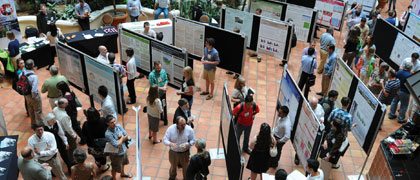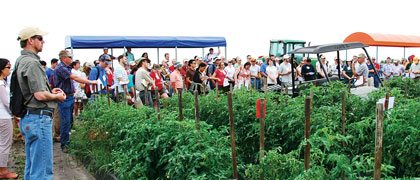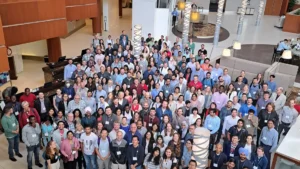Plant Breeders Look to the Future
Members of the National Association of Plant Breeders and the Plant Breeding Coordinating Committee flocked to Florida to network, strategize and take in new breeding developments at the annual conference.
The National Association of Plant Breeders and the Plant Breeding Coordinating Committee had their eyes fixed firmly forward during their annual conference in Tampa, Fla., June 2 to 5, where more than 170 NAPB and PBCC members came together around the theme of positioning plant breeding for the future.
New and future technologies for plant breeding, updated education models for breeders and the challenges facing agriculture in the near future were some of the topics covered by dozens of speakers at the event, according to past PBCC chair Allen Van Deynze, who noted a particular focus of this year’s event was the inclusion of about 55 graduate students attending the conference.
A poster session with graduate students allowed plant breeders to find out more about what the 70 students who attended the conference were working on.
Some reorganization within the NAPB and PBCC also took place, including a move by the NAPB to improve the advocacy power of plant breeders on Capitol Hill.
Van Deynze, who turned over leadership of the PBCC during the organizational portion of the June meeting, has been the committee’s University of California, Davis representative since its inception in 2007, when the group was struck as an official United States Department of Agriculture committee with the goal of acting as a forum for plant breeders to interact with each other as well as with legislators. He is also an active member of the NAPB, which was formed out of the PBCC as an independent organization to share concerns with legislators.
Discussing those concerns with legislators, notes Van Deynze, is something that group is going to be taking much more seriously now that it has struck an official NAPB Advocacy Committee to pursue larger funding opportunities.
“We want to go to Washington with some clear messages,” Van Deynze says, noting that while the specifics of those messages are still being worked out, they will advocate for more funding and grant opportunities for an area he feels has been sorely neglected by the federal government.
“Of course we want to advocate for a higher budget—our budgets have been, overall, I would say, embarrassing for agriculture in general. The USDA budget for grants has been flat since the year 2000,” Van Deynze says. “We really want double, but we’d be happy with 10 percent. We realize that [an increase] has to be incremental, but our goal is to at least double it, eventually.”
NAPB past president David Stelly adds that “it’s imperative that breeding capacities be re-invigorated, so that the nation can address the very difficult challenges posed by the need to provision itself, but do so while facing multiple significant challenges: new pathogens, pests, higher temperatures and less rain, but also using less land, less water and fewer energy and chemical inputs.”
In addition to a reorganization of the PBCC and NAPB, the event focused on a number of directions plant breeding will be moving in the coming months and years, including a look at the technology being developed to make it easier for plant breeders to analyze and interpret the massive amounts of data they collect.
“The big problem in plant breeding right now is that we can create data faster than we can analyze it,” Van Deynze explains.
One of the major developments in this area has been the iPlant initiative, which aims to develop both the hardware infrastructure and the algorithms and software to help breeders handle the massive amounts of data they’re able to collect. Stephen Goff, director of the iPlant Collaborative, made a presentation to the conference detailing the project, which is currently in its fifth year of development.
Another new tool for plant breeders rolled out in June after five years of development is the Integrated Breeding Platform, which was presented to the conference by Jean-Marcel Ribaut, director of the Consultative Group on International Agricultural Research’s Generation Challenge Program.
“It’s like a breeder’s toolbox, in that it’s a database and a program that can use different software to track plants through the different stages of breeding programs,” Van Deynze says.
Another hot topic at this year’s conference was new ways of educating plant breeders, including plant breeding academies launched by private corporations such as Syngenta.
“What we try to focus on is new education models—you can have a joint degree, for example, across institutions,” Van Deynze says. “We talked a lot about distance education and combinations of distance education with in-house programs and plant breeding academies, which are run by some of the private companies internally.”
PBCC/NAPB members discuss tomato breeding at the Gulf Coast Research and Education Center.
Those internally-operated education programs are a way for private companies to ensure that their prospective staff are all trained the same way, Van Deynze says. Heather Merk, program lead of the Syngenta Breeding Academy, presented information about that particular program.
“It’s not uncommon for private companies to run internal education programs,” says Van Deynze. “Syngenta isn’t the only company that’s doing that, not at all. We have our own plant breeding academy here at Davis that’s been around since 2006, and there’s a number of companies doing that,” he notes. “The basic difference is a customized course versus a more general course with general topics. These kinds of academies and programs complement the professional development classes that universities might be putting on.”
Part of the conference’s forward-looking theme also included taking a special interest in the grad students who attended the event, including having them set up a poster competition to explain what they are working on as well as giving the students more of an opportunity to address the conference than in previous years.
“We gave about 30 students the opportunity to speak for one minute—that sounds like not a lot of time, but it was extremely successful, because it gave the students a chance to put their face to their name,” says Van Deynze, noting that the conference also included the chance for grad students to participate in a life skills-building workshop, which covered budget management and understanding the “business” of plant breeding better.
“Everybody thought this was a great interaction with the graduate students—I think we’re just going to do more and more in that regard as time goes on,” says Van Deynze, adding that the student involvement was well received by conference attendees.
“I think it went very smoothly—this was one of the best [conferences] we’ve had so far, because of course you learn as you go,” he says. “The big difference was I think we had the right mix of interaction and the tours were really great, and the people were just very involved the whole way.”
John Towns













